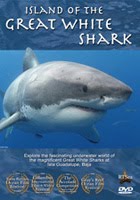 One of the more unusual sharks found throughout the temperate and tropical waters of the western Pacific Ocean is the wobbegong. A bottom-feeder, the wobbegong has camouflaging motley coloration and frilly appendages around its mouth that some believe act as a lure for unsuspecting prey.
One of the more unusual sharks found throughout the temperate and tropical waters of the western Pacific Ocean is the wobbegong. A bottom-feeder, the wobbegong has camouflaging motley coloration and frilly appendages around its mouth that some believe act as a lure for unsuspecting prey.While the populations of various shark species that cruise the reefs can be used as a barometer as to the overall health of the ecosystem, according to researchers in Australia, the behavior of the wobbegong can also be used as an indicator of a healthy environment. By studying the behavior and understanding what geographical or habitat factors determine that behavior, then any recorded change in behavior may point to changes in the marine environment.
 Dr. Susan Theiss of the University of Queensland has studied the light sensitivity of several wobbegong species and how different sensitivity establishes different levels of activity. She reported, "It appears that the wobbegong species we studied have different visual adaptations that could be linked to times of increased activity. For example, the spotted and dwarf spotted wobbegongs are probably more active in low-light conditions such as night time, or in the early morning or late afternoon, whereas the western and ornate wobbegongs are visually suited to a range of light conditions."
Dr. Susan Theiss of the University of Queensland has studied the light sensitivity of several wobbegong species and how different sensitivity establishes different levels of activity. She reported, "It appears that the wobbegong species we studied have different visual adaptations that could be linked to times of increased activity. For example, the spotted and dwarf spotted wobbegongs are probably more active in low-light conditions such as night time, or in the early morning or late afternoon, whereas the western and ornate wobbegongs are visually suited to a range of light conditions."Professor Shaun Collin of the University of Western Australia, who also worked with Dr. Theiss in the study, said, "Almost nothing is known about the behaviour of wobbegongs, but what our research on the visual systems can do is predict their behaviour, so we look at the shark's visual system at the level of the photoreceptors, which are the cells that detect light. If you see these common species interacting and behaving normally in a particular environment, this can be a good indicator of the health of that part of the ocean."
 Marine biologists study the role that sharks play as predators and scavengers in maintaining a healthy marine ecosystem. Declining shark populations, due to commercial overfishing, can have pronounced effects on the ocean environment - from changes in the health of other fish species to degraded water quality and even reduced oxygen levels. By monitoring the behaviors of animals like the wobbegong shark, researchers gain insight into how animals respond to changes in their environment.
Marine biologists study the role that sharks play as predators and scavengers in maintaining a healthy marine ecosystem. Declining shark populations, due to commercial overfishing, can have pronounced effects on the ocean environment - from changes in the health of other fish species to degraded water quality and even reduced oxygen levels. By monitoring the behaviors of animals like the wobbegong shark, researchers gain insight into how animals respond to changes in their environment."This research is important in establishing general trends and predictions in biogeography and ecology that we don't yet have data for," Dr Theiss said.
Oh, and yes, we are related. I am her proud uncle. Dr. Theiss is a U.S. national working for the University of Queensland and I someday hope to get across the Pacific and have her show me some of her frilly-mouthed friends first hand.
Read about the wobbegong research in Science Alert.

















No comments:
Post a Comment